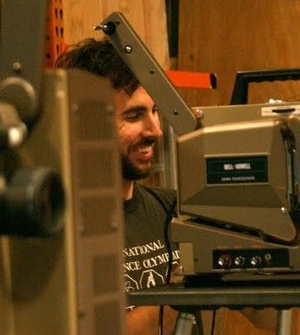Roger Beebe
Contributing Artist experimental film 2018-2020
Department of Art, The Ohio State University
Biography
I started making films in the mid-1990s with very little knowledge of experimental film, inspired more by European art cinema and experimental fiction. Over the course of the first five years of my filmmaking, I found my way to more experimental forms, partially as an aesthetic matter and partially because of the mode of production, as I realized that making even experimental forms of cinematic narrative required a kind of labor that was both alien and alienating. The form of cinema that I settled on at the end of that period generally had as its content the world of found images and the "found" landscapes of late capitalism, and my work increasingly was made with modest means, both financially and technically. Starting around 2006 my work took a further turn to begin exploring multi-projector performance, largely on 16mm film, and cameraless techniques including direct animation, laser printing and cutting directly on the surface of the film, contact printing and hand-processing, and more. Since 2007, my primary mode of exhibition has been in the form of extended multi-city tours of my work, where I load up my Prius with eight projectors, a p.a., stands, cables, etc. and show my films for 2-3 months at a stretch (with such tours in 2007, 2009, 2011, 2015, and 2018). These tours turn the screenings into events—an important argument for the specialness of cinema in this era of omnipresent screens—and allow for an interpersonal exchange between me and the audience while also fostering the audience’s sense of itself as a community.
Q & A
What makes more livable futures for you?
My answers to this question might tend toward the reactive. I see so much that seems unlivable—the condoization of American cities, the landscapes of planned obsolescence, the gutting of important institutions like public universities—that much of what I fight for is preserving those things that are being displaced by these new and degraded forms. My filmmaking and film pedagogy are about that—a cinema that rejects convenience and consumability in the name of something more complex, meaningful, and, hopefully, lasting. But finding a balance between the impulse to preserve these older forms and embracing new and meaningful contributions to these traditions and institutions is perhaps the trickiest part of the equation. The internet, for example, has allowed me to participate in a global community of like-minded makers, even if it is plagued with problems of access, of consumption (of computers that are thrown out every few years, of energy with each Google search and each post). Figuring out how to negotiate these contradictions may be the key to a livable future for me.
What are you reading, viewing, listening to right now?
Most of my pleasure reading the last several years has been contemporary fiction by women and people of color. Like almost everyone coming through our educational system I’ve been raised primarily on a diet of white male voices, and it’s been really important to encounter these other narratives and other worldviews. To think I only read Zora Neale Hurston for the first time a few years ago! And never encountered James Baldwin beyond passing mention in school! Contemporary writers like Rachel Cusk, Maggie Nelson, Sheila Heti and so many others have been very important to me in recent years, even if it’s not explicitly tied to my work as a filmmaker.
As for what I’m listening to, while I maintain a steady diet of the indie rock that was the first music that defined my own personal aesthetic, I’ve also been finally developing a relationship with World Music and overcoming my nervousness about the connection of that taste culture to the legacy of colonialism. I’ve been interested in forms that embrace hybridity and complexity of that colonial legacy like the Congotronics records or the recent Terry Riley reworking In C in Mali. I also listen to podcasts constantly. Ear Hustle, produced inside San Quentin largely by inmates of the prison, is a current favorite with its important balance of personal storytelling and greater political narratives.
What I’m viewing is largely a product of what I’m teaching (especially this semester with all the expanded cinema programming I’m doing), although I’m supplementing that with offerings from MUBI, a curated website that offers only 30 films at a time and that challenges me to watch something better than the latest Netflix comedy specials.
What practices are sustaining you?
Currently I’m most sustained by the film community that I see forming here in Columbus. There were amazing film programs on offer here well before my arrival, but I’ve been disappointed that those programs are so often underattended. Lately I’m getting a sense that something new is emerging, that attendance is up at these events, and that more people are engaging with alternative cinemas, whether that’s in the form of the programming I’ve been offering this semester or at the amazing screenings at the Wexner Center or elsewhere around town. Alternative cinemas have never been simply a cultural matter for me—they come connected to a whole relationship to contemporary capital (largely an adversarial one that champions things like community, conservation, intimacy, knowledge-sharing, and personal expression) that can be potentially transformative.
